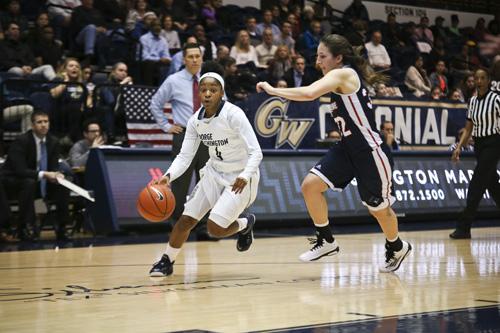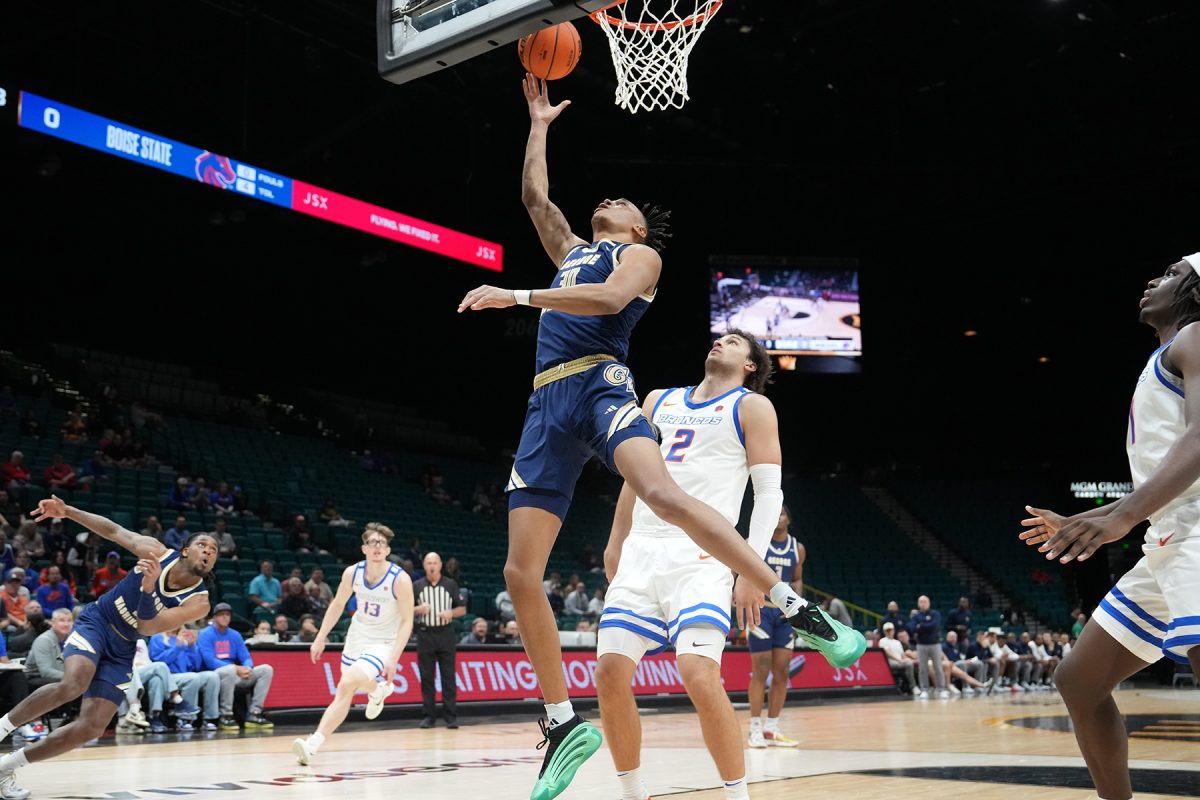
This post was written by Hatchet staff writer Josh Solomon.
The leading scorer for the Dukes sank a 3-pointer from the top of key, draining it over the outstretched hand of Jonquel Jones.
Nothing too out of the norm for Duquesne – the Atlantic 10’s top 3-point shooting team – but it was anything but the usual Wednesday night in the Smith Center as the Colonials locked down.
“We turned it up another level today,” head coach Jonathan Tsipis said of his defense.
Star guard April Robinson made her team’s first trey of the game with 5:30 to play, down 70-44. The Colonials, now ranked nationally at No. 24 in the USA Today Coaches Poll, were well on their way to their 15th straight win. Robinson hit one more in the final minutes, irrelevant in the 83-56 blowout.
The Dukes finished 2-13 from behind the line, good for 15.4 percent. Heading into the game, Duquesne was first in the conference with a 36.3 3-point field goal percentage, second in scoring offense at 74.9 points per game and near the top of many of the league’s rebounding and assists numbers. An all around good offensive team.
Their problem? They ran into a GW team that is not only tied for first with the Duke Blue Devils for the best rebounding margin in the nation, but a Colonials crew that put some defensive lapses on the road behind them and turned them into critical points at home.
Before heading out on a two-game road trip to Rhode Island and Massachusetts, Tsipis had a long talk with his players about where they were in the league defensively. But in truth it was the Colonials offense that was showcased on the trip and the team leaned on scoring potency instead of stopping their opposition.
That changed back in the Smith Center, as depth and speed caused trouble for Duquesne in the Smith Center. Guards like sophomores Hannah Schaible and Shannon Cranshaw, senior Chakecia Miller and senior Lauren Chase helped extend the GW defense. The Dukes attempted seven threes in the first half, but rarely with an open look.
“All of a sudden to know, we have the depth right now where we can play people for three and a half to four minute spurts and they can play as hard as possible and as locked in, and we’re going to get them a break,” Tsipis said. “And to be able to do that on the defensive end and then the ability to get out and run in transition.”
Schaible credited “intelligent play,” and an in depth scouting report from assistant coach Bill Ferrara shaped a diligent defense.
“Whether it’s a shooter or a driver, we were set and basically knew what we had to do to keep them at bay and win the game,” Jones said, who finished with 22 points, 17 rebounds and two blocks.
Every player on the court for Duquesne had an individual scouting report, one that prompted players to go under the screen on some ball screens and over on others, like with Robinson.
“We focused a lot on chasing them off the 3-point line so that they can’t even get those shots up,” Schaible said.
Chasing was the keyword, one that Tsipis used as well. The man to man defense spread into a full court zone for long stretches in the first half, creating turnovers and forcing shooters into an unnatural spot in the half court. Guards would often extend out to the 3-point line when defending the basket.
The last time Duquesne finished with such a low 3-point field goal percentage was against Fordham last year in the A-10 tournament, hitting 1-11 then. GW has had one of the top 3-point field defenses all season long. They are second in the conference, allowing opponents just a 26 percent accuracy rate on the three.
Though players like Jones get much of the credit for the number in front of GW’s name, all 14 Colonials on the active roster got a piece of the action, able to defend the target now on their back.
“You saw today there was a tremendous amount of pride that we put ourselves in position to be successful,” Tsipis said. “One through 14, they all knew exactly what those kids could do. It’s one thing to know, it’s a second to carry it out.







